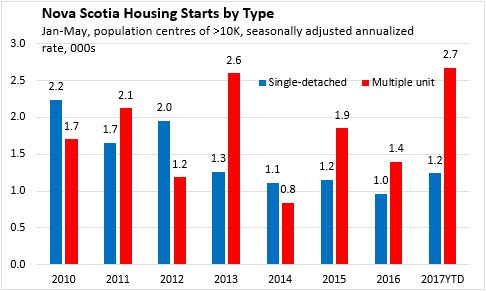The Economics and Statistics Division maintains archives of previous publications for accountability purposes, but makes no updates to keep these documents current with the latest data revisions from Statistics Canada. As a result, information in older documents may not be accurate. Please exercise caution when referring to older documents. For the latest information and historical data, please contact the individual listed to the right.
<--- Return to Archive
For additional information relating to this article, please contact:
June 08, 2017CMHC PRELIMINARY HOUSING STARTS, MAY 2017 
Nova Scotia's housing starts (seasonally adjusted annualized rate) decreased 28.6 per cent to 4,583 in May compared to April, with the Halifax market down 48.1 per cent, to 2,833.
Compared to May 2016, Nova Scotia housing starts were down 3.7 per cent while Halifax starts were down 0.7 per cent.
Through the first five months of 2017, Nova Scotia housing starts were up 52.0 per cent compared to the same period in 2016. That growth was driven largely by increases in multiple-unit starts in the Halifax market.

Across the country, the pace of housing starts decreased by 8.8 per cent to 194,663 in May compared to April. Housing starts were 4.1 per cent higher than in May 2016.

Housing starts for January-May 2017 were up in all but three provinces compared to the first five months of 2016, led by Manitoba, Prince Edward Island, and Nova Scotia in percentage terms. Newfoundland and Labrador, New Brunswick, and British Columbia had lower housing starts than in January-May 2016.

The six month average of housing starts increased through most of 2016, starting the year at around 2,500 and rising to around 4,000 by the end of the year. That trend has continued, though at a slower pace, in 2017. Similarly, the Halifax trend also increased over the past year.

Note: Urban areas are defined as areas over 10,000 people
Statistics Canada: CANSIM table 027-0054, CANSIM table 027-0051
CHMC Housing Market Information Portal
<--- Return to Archive